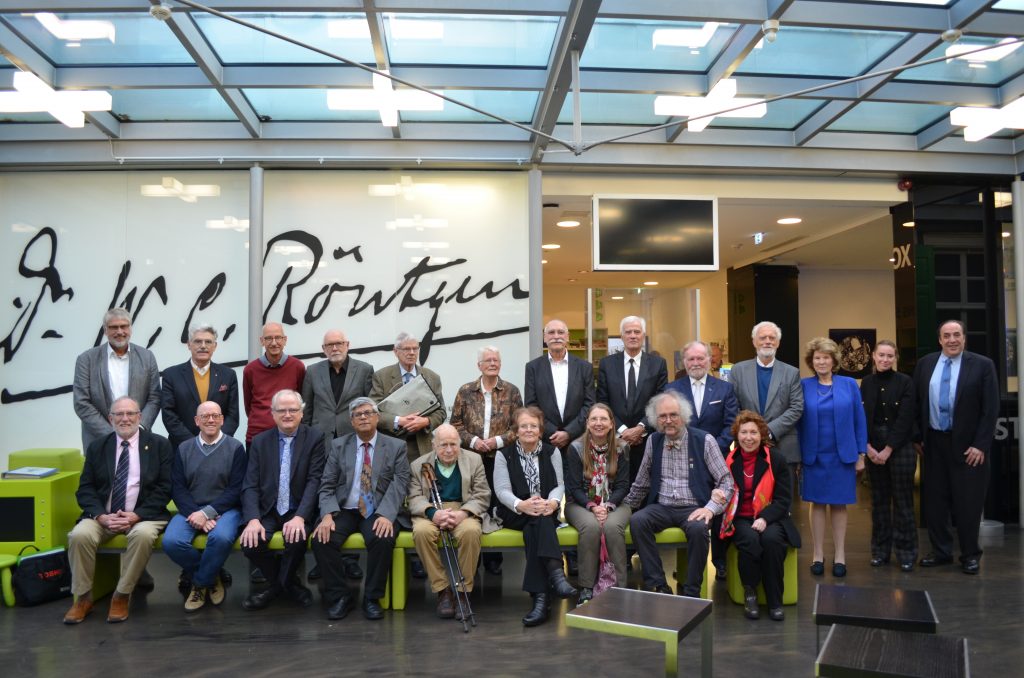Report by Dr Arpan K Banerjee
Chair of ISHRAD
This year’s 12th ISHRAD symposium was held jointly with the 2nd Forum of the History Commission of the DRG (Deutsche Röntgen Society) in the Deutsches Röntgen Museum in Remscheid-Lennep, Germany. This year celebrates the centenary of the death of Röntgen, so it was nice to hold the symposium in the museum dedicated to his life built a few hundred metres from his birthplace now being looked after by the DRG.
Dr Uwe Busch the director of the museum is to be thanked for putting together the meeting and hosting it in the museum.
On the Friday 27 0ct the museum hosted a talk delivered in German by Prof Dr. Gerhard van Kaick from Heidelberg who spoke on the diagnosis and therapy of Thorotrast™ induced tumours. He was the principal author of the important German Thorotrast study from 1999. Thorotrast was used as a contrast agent from the 1930’s to the 1950’s having been championed by Egas Moniz but sadly was found later to cause tumours especially liver and biliary cancer and leukaemias. Almost 10 million patients were treated with this contrast agent whose long half-life of 22 years and alpha decay resulted in a higher cancer risk following its administration.
In the evening Prof van Kaick was interviewed in the Röntgen House and this was followed by supper in the museum with a tour of the exhibits.
The following day started off with the customary ISHRAD board meeting chaired by Dr Arpan K Banerjee the current Chairman of ISHRAD.
After welcome addresses from Prof Heinz –Peter Schlemmer from the DRG Historical commission and Dr Arpan K Banerjee from ISHRAD, the meeting started with the day filled with talks on a wide range of radiology historical topics.
The first session celebrated the centenary of Röntgen’s death with an opening talk by Marcel Michels, the Röntgen museum archivist, who talked about his fascinating new findings from the Röntgen archive. Dr Anne Marie de Knecht –van Eekelen gave the next two talks including Prof Rosenbusch’s paper as he was unable to attend. Both the talks, the first on Röntgen the teacher and the next on Gunning who influenced Röntgen provided important insights into Röntgen.
In the next session on the History of radiation biology/protection, Professor Christian Streffer from Essen delivered an important, scholarly talk on key points of radiobiological measures.
The next talk was a fascinating, nicely illustrated presentation on ‘Radiation Oncology and Art’ by Michael Ortel. Oliver Micke delivered the following interesting talk on the Austrian radiology pioneer Guido Holzknecht one of the early radiology martyrs from Vienna who died aged 58 as a consequence of his exposure to radiation. Edwin Aird from UK, talked about Jack Fowler and fractionation radiotherapy.
Mats Geijer from Sweden talked about Swedish contributions to radiation protection including the work of Sievert.
In the afternoon Arpan K Banerjee from U.K. started the session with his talk on ‘Early days of radiology In India’ mentioning the pioneers Sircar and Bose names not very familiar in the West.
Renaat Van den Broeck from Brussels spoke on the ‘Exploration of cathodography in Belgium’, he highlighted the Belgian pioneers of radiology.
Robert Dondelinger followed with his talk on ‘Father and son jointly announce the discovery of X-rays in two consecutive press articles’. The story of Zacharias Lecher editor of Die Presse in Vienna and Ernst Lecher the physicist from Vienna is an unusual one.
The next talk ‘The first images of radiology from France’ by Denis Krause reminded us of the contributions of French pioneers Le Roux, Gaston Seguy, Toussaint Barthelemy and Paul Marie Oudin.
The session concluded with a talk by Markus Stuhrmann on Marie Kundt and Eugen Goldstein ‘The first Xray exposure in Berlin’.
The final session included talks by Adrian Thomas from UK on William Morgan, a Welsh political radical, actuary, and scientist’. William Morgan was one of the first to record Invisible Light when a current was passed through a partly evacuated glass tube.
Robert George from Australia talked on the father and son William and Lawrence Braggs and gave a nice overview of their careers.
Tim Overkempe from Antwerp gave a nice talk on X-ray imagery as popular entertainment and new visual media show with particularly nice images and clips to illustrate his talk.
Judith Amorosa from USA and Liz Beckmann from UK concluded with a talk ‘Practising Radiology for 1000 years by Women and who are behind them’.
Votes of thanks were given at the end of the proceedings and the Historical Commission of the DRG hosted a pasta themed party in the Röntgen House in the evening to conclude what had been an excellent conference. Thanks again to Dr Uwe Busch, Prof Heinz Peter Schlemmer and other team members for their hard work in making the meeting such a success.

